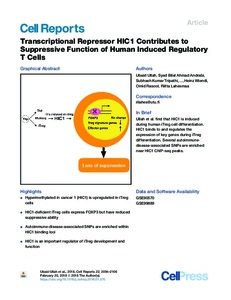Transcriptional Repressor HIC1 Contributes to Suppressive Function of Human Induced Regulatory T Cells
Urvashi Bhatia; Johanna Tuomisto; Kartiek Kanduri; Syed Bilal Ahmad Andrabi; Kanchan Bala; Harri Lähdesmäki; Sari Lehtimäki; Deepankar Chakroborty; Laura L. Elo; Sini Rautio; Catharina C. Gross; Heinz Wiendl; Riitta Lahesmaa; Ubaid Ullah; Subhash Kumar Tripathi; Omid Rasool; Obaiah Dirasantha
Transcriptional Repressor HIC1 Contributes to Suppressive Function of Human Induced Regulatory T Cells
Urvashi Bhatia
Johanna Tuomisto
Kartiek Kanduri
Syed Bilal Ahmad Andrabi
Kanchan Bala
Harri Lähdesmäki
Sari Lehtimäki
Deepankar Chakroborty
Laura L. Elo
Sini Rautio
Catharina C. Gross
Heinz Wiendl
Riitta Lahesmaa
Ubaid Ullah
Subhash Kumar Tripathi
Omid Rasool
Obaiah Dirasantha
CELL PRESS
Julkaisun pysyvä osoite on:
https://urn.fi/URN:NBN:fi-fe2021042719010
https://urn.fi/URN:NBN:fi-fe2021042719010
Tiivistelmä
Regulatory T (Treg) cells are critical in regulating the immune response. In vitro induced Treg (iTreg) cells have significant potential in clinical medicine. However, applying iTreg cells as therapeutics is complicated by the poor stability of human iTreg cells and their variable suppressive activity. Therefore, it is important to understand the molecular mechanisms of human iTreg cell specification. We identified hypermethylated in cancer 1 (HIC1) as a transcription factor upregulated early during the differentiation of human iTreg cells. Although FOXP3 expression was unaffected, HIC1 deficiency led to a considerable loss of suppression by iTreg cells with a concomitant increase in the expression of effector T cell associated genes. SNPs linked to several immune-mediated disorders were enriched around HIC1 binding sites, and in vitro binding assays indicated that these SNPs may alter the binding of HIC1. Our results suggest that HIC1 is an important contributor to iTreg cell development and function.
Kokoelmat
- Rinnakkaistallenteet [27094]
